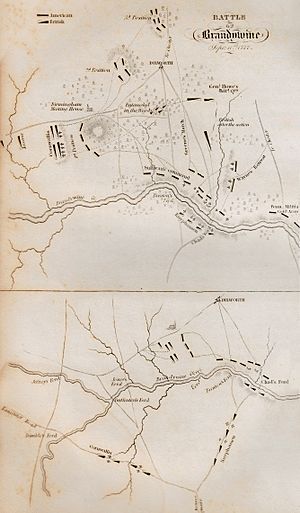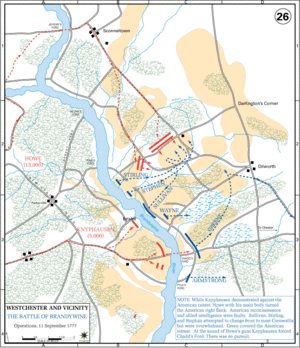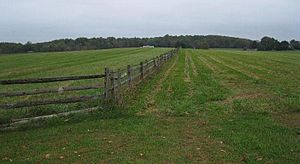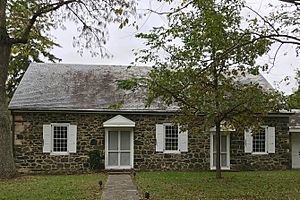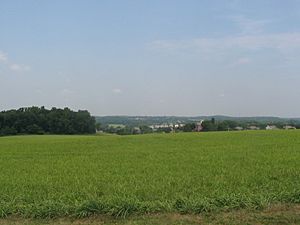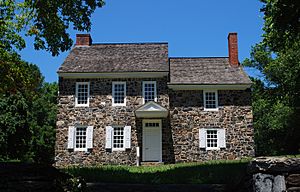Battle of Brandywine facts for kids
Quick facts for kids Battle of Brandywine |
|||||||
|---|---|---|---|---|---|---|---|
| Part of the American Revolutionary War | |||||||
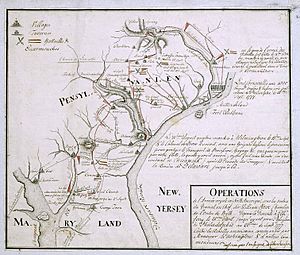 Hessian map of the Philadelphia campaign |
|||||||
|
|||||||
| Belligerents | |||||||
| Commanders and leaders | |||||||
| Strength | |||||||
| 15,500 | 14,600 | ||||||
| Casualties and losses | |||||||
| 93 killed 488 wounded 6 missing |
250 killed 600 wounded 400 captured |
||||||
|
Pennsylvania Historical Marker
|
|||||||
| Designated: | March 18, 1952 | ||||||
The Battle of Brandywine was a major fight during the American Revolutionary War. It happened on September 11, 1777, near Chadds Ford, Pennsylvania. The battle was between the American Continental Army, led by George Washington, and the British Army, led by General Sir William Howe.
More soldiers fought at Brandywine than in any other battle of the American Revolution. It was also one of the longest single-day battles, lasting 11 hours. The British won this battle. They forced the American army to retreat. This victory allowed the British to capture Philadelphia, which was the American capital at the time.
Contents
Why the Battle Happened
In the summer of 1777, British General Sir William Howe wanted to capture Philadelphia. This city was very important to the Americans. It was where the Continental Congress met.
Howe's large fleet of over 260 ships carried about 17,000 British soldiers. They sailed from Sandy Hook, New Jersey and landed in Maryland. This was near the Elk River.
General George Washington knew the British were coming. He placed his American forces, about 20,300 soldiers, between the British landing spot and Philadelphia. Washington's goal was to stop Howe from reaching the capital.
Washington chose to defend the area around Brandywine Creek. This creek had important crossing points called "fords." The main road from Baltimore to Philadelphia crossed the creek at Chadds Ford. Washington thought this was the best place to fight.
Howe, however, had better information about the area. He planned a clever move called a flanking maneuver. This meant he would send part of his army to attack Washington from the front. But the main part of his army would march around Washington's side to surprise them.
About 6,800 British soldiers, led by Wilhelm von Knyphausen, marched toward Chadds Ford. The rest of Howe's army, about 9,000 men led by Lord Cornwallis, marched north. They crossed the Brandywine Creek at two unguarded fords. Washington's scouts had missed these crossings. Cornwallis's troops then turned south to attack the American army from behind.
The Battle Begins
The battle started on September 11 with a thick fog. This fog helped hide the British movements. Washington received confusing reports about where the British were. He still believed the main attack would be at Chadds Ford.
Knyphausen's Attack
At 5:30 a.m., British and Hessian troops began marching toward Chadds Ford. They met American soldiers about four miles west of Chadds Ford. Small fights broke out. The British pushed the Americans back toward the creek.
The fighting even happened near the Old Kennett Meetinghouse. Inside, pacifist Quakers were holding their weekly service. One Quaker later wrote that it was "quiet and peaceful within" despite the "noise and confusion without." The British eventually pushed the Americans back at Chadds Ford.
Cornwallis's Surprise Attack
Meanwhile, Cornwallis's main British column had started its long march at 5:00 a.m. This 17-mile march took about nine hours. Around 2 p.m., the British appeared on the American army's right side. They rested on Osbourne's Hill, which gave them a good view.
Washington quickly ordered General John Sullivan to move his divisions north. They had to try and block this surprise attack. The Americans tried to form new lines on high ground near Birmingham Friends Meetinghouse.
Around 4 p.m., the British attacked. They surprised one American division, causing it to break apart. Other American divisions, led by Adam Stephen and Lord Stirling, fought hard. They were helped by cannons. However, the British soldiers eventually forced them to retreat. The Marquis de Lafayette, a French officer helping the Americans, was wounded while trying to rally the retreating troops.
Washington's Efforts to Save the Army
Around 6 p.m., Washington and General Nathanael Greene arrived with more soldiers. They tried to stop the British, who had taken Meeting House Hill. Greene's soldiers, along with the remaining American troops, fought bravely. They held off the British for almost an hour. This gave the rest of the American army time to escape.
As darkness fell, Greene's division also began to retreat. The British could not chase them in the dark. The Americans had to leave many cannons behind because their horses were killed.
Knyphausen's Final Push
When Knyphausen heard Cornwallis's attack, he launched his own strong attack at Chadds Ford. He broke through the American lines there. These American soldiers also had to retreat, leaving most of their cannons.
The American army retreated to Chester. Most arrived by midnight. The retreat was well-organized. Lafayette, even though he was wounded, helped create a safe spot for soldiers to gather. This helped make the retreat more orderly.
Who Won and What Was Lost
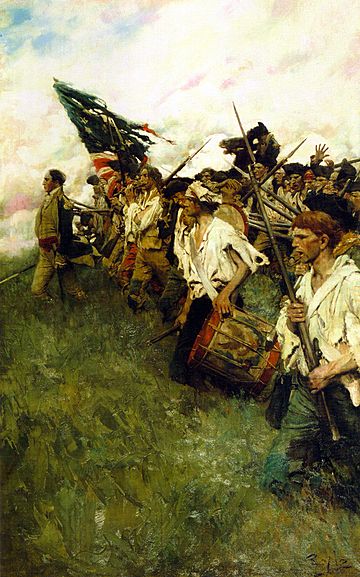
The British won the Battle of Brandywine. They reported about 587 casualties (soldiers killed, wounded, or missing). This included 93 killed and 488 wounded.
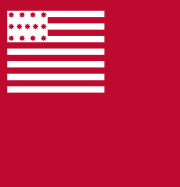
The American army lost more soldiers. British reports said about 300 Americans were killed, 600 wounded, and 400 captured. General Greene estimated that the Americans lost between 1,200 and 1,300 men in total. The British also captured 11 of the 14 American cannons. Lafayette was among the wounded Americans.
What Happened Next
Even though the British won, they could not completely destroy Washington's army. Washington had made a mistake by leaving his right side open. But the brave fighting of some American divisions bought enough time for most of the army to escape. Washington wrote to the Continental Congress that his men were still in good spirits and ready to fight again.
The British and American armies moved around each other for several days. There were a few smaller fights. Two weeks after Brandywine, on September 26, 1777, British forces marched into Philadelphia without a fight. The city remained under British control for nine months.
Before Philadelphia fell, important bells in the city were taken down and hidden. This included the famous Liberty Bell. It was moved to Allentown and hidden under floorboards. The Continental Congress also left Philadelphia. They moved first to Lancaster and then to York, Pennsylvania.
Today, many U.S. Army units can trace their history back to the American units that fought at the Battle of Brandywine.
Preserving the Battlefield
Brandywine Battlefield Historic Site is a special place. It is a National Historic Landmark. The park is managed by the Pennsylvania Historical and Museum Commission. It covers 52 acres near Chadds Ford. It is part of the original battle site.
The American Battlefield Trust and its partners have also worked to protect and preserve more land from the battlefield.
-
Birmingham Friends Meetinghouse in 2017
-
George Washington's headquarters
See also
 In Spanish: Batalla de Brandywine para niños
In Spanish: Batalla de Brandywine para niños


